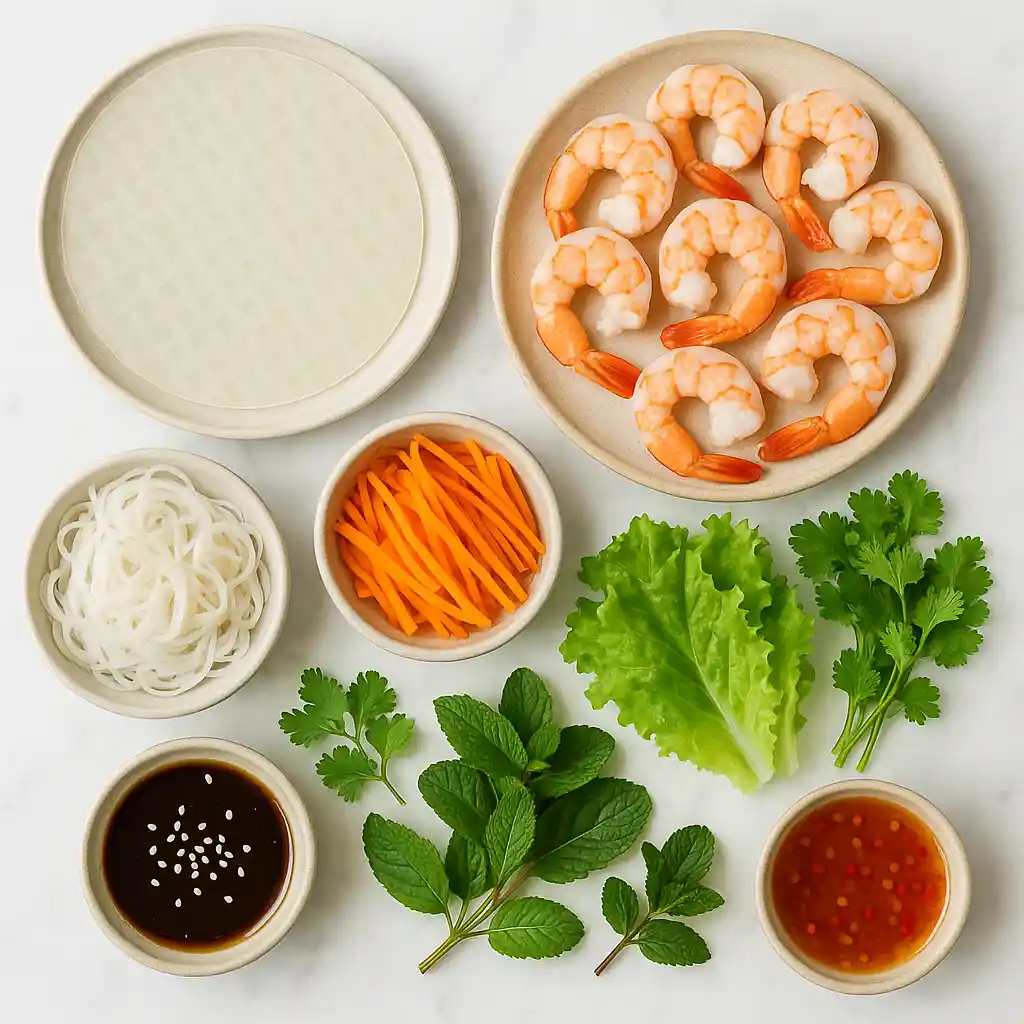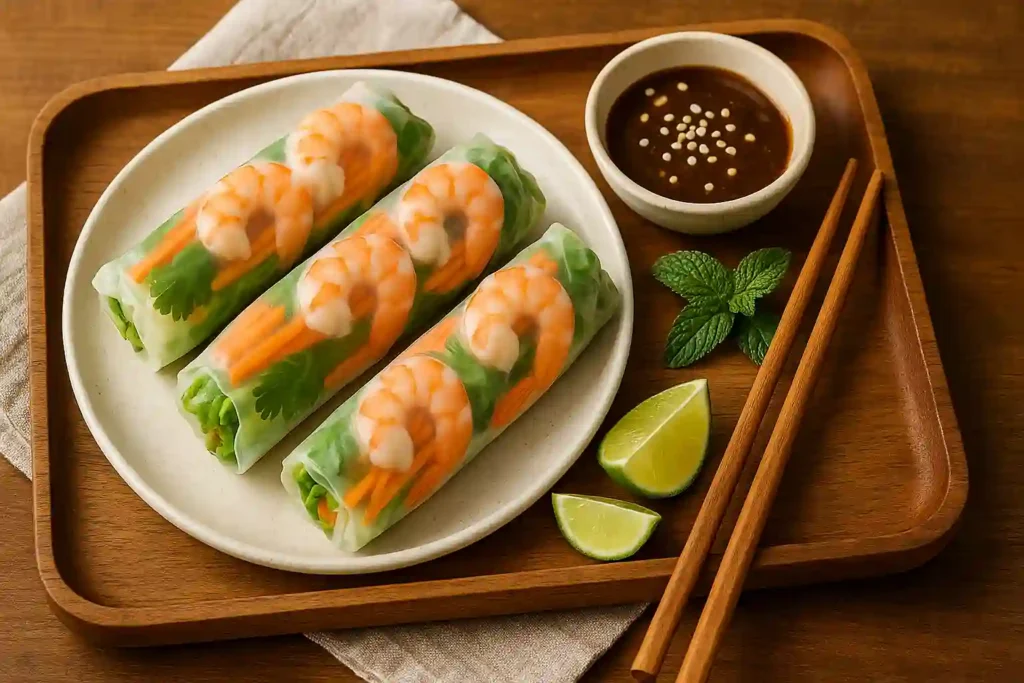Table of Contents
The Story & Intro
A Family Tradition Wrapped in Rice Paper
Hi there! I’m Lily Jason—mom to a wonderful little girl named Nouha and the heart behind FastFlavorBites. I believe food is more than just nourishment—it’s memory, comfort, and connection. That belief came from my grandmother’s tiny kitchen, where I first learned how to roll rice paper rolls. I remember her gentle hands dipping the rice paper, laying it flat on a damp cloth, and expertly rolling each one with care. There was no rush, just laughter, steam from the herbs, and the rhythm of tradition being passed down.
Now, it’s my turn to pass that love on. Nouha and I roll rice paper rolls together often. It’s become our go-to when we want something light, fun, and hands-on. She gets to pick her fillings (sometimes it’s tofu, sometimes strawberries!), and I get to sneak in a few veggies. Whether we’re rolling lunch for two or a platter for a gathering, the process feels both playful and purposeful.
At FastFlavorBites, we’re all about food that’s fast, flavorful, and made with heart. Rolling rice paper rolls fits that vision perfectly. It’s a simple process once you know the steps, and it’s a dish that invites creativity. Don’t worry if your first few look messy—mine did too! But with a little practice and some helpful tips, you’ll be rolling rice paper rolls like a pro in no time.
The Basics of Rolling Rice Paper Rolls
To begin rolling rice paper rolls, you’ll need a dry sheet of rice paper and a shallow bowl filled with warm water. Gently dip the sheet for 5–7 seconds until it softens. Place it on a damp surface like a clean tea towel or plate. Add a few slices of your fillings—cooked shrimp, rice noodles, lettuce, herbs—toward the bottom third. Start by folding the bottom edge over the filling, tuck in both sides, and roll it upward firmly, just like you would a burrito.
This foundational method is used around the world, especially in Vietnamese cooking. For more practice with prep skills, you’ll love our Smoker Recipes for Turkey Breast.

Why Rice Paper Rolls Are a Healthy Choice
Light, Nutritious, and Full of Flavor
One of the best things about rice paper rolls is how they manage to be both healthy and deeply satisfying. Whether you’re watching your calories, cutting back on gluten, or just looking for clean, whole food meals, rolling rice paper rolls fits the bill beautifully.
Each rice paper sheet contains only about 30 to 35 calories and is virtually fat-free. When you roll them up with lean proteins like shrimp, tofu, or chicken breast and pack them with vegetables—cucumbers, lettuce, bell peppers, shredded carrots—you get a satisfying meal that won’t weigh you down. And the freshness? Unbeatable.
Unlike deep-fried alternatives, these rolls are never greasy. They let the ingredients shine. Herbs like mint and cilantro add brightness.
Print
How to Roll Rice Paper Rolls: A Step-by-Step Guide
- Total Time: 15 minutes
- Yield: 8 rolls 1x
Description
Learn how to roll rice paper rolls with this easy recipe. Light, fresh, and packed with flavor.
Ingredients
8 round rice paper sheets
1 cup cooked shrimp, sliced
1 cup cooked vermicelli noodles
1/2 cup shredded lettuce
1/4 cup fresh mint leaves
1/4 cup fresh cilantro
1/4 cup julienned carrots
Small bowl of warm water
Instructions
1. Fill a shallow dish with warm water.
2. Dip one rice paper sheet in water for 5–7 seconds.
3. Lay the softened sheet flat on a damp towel.
4. Add shrimp, noodles, lettuce, mint, cilantro, and carrots near the bottom third.
5. Fold the bottom edge over the filling, fold in both sides, and roll upward tightly.
Notes
Avoid over-soaking the rice paper or it may tear.
Customize with tofu, mango, or grilled chicken depending on your taste.
For best results, serve with a homemade peanut or hoisin dipping sauce.
- Prep Time: 15 minutes
- Cook Time: 0 minutes
- Category: Appetizer
- Method: No-cook
- Cuisine: Vietnamese
Nutrition
- Serving Size: 2 rolls
- Calories: 120
- Sugar: 2g
- Sodium: 150mg
- Fat: 1g
- Saturated Fat: 0g
- Unsaturated Fat: 1g
- Trans Fat: 0g
- Carbohydrates: 18g
- Fiber: 2g
- Protein: 6g
- Cholesterol: 25mg
Great for All Diets
Because rice paper contains only rice flour, tapioca starch, water, and salt, it’s naturally gluten-free and safe for those avoiding wheat. It’s also free from dairy, eggs, and added sugars—perfect for vegan, vegetarian, and low-FODMAP eaters depending on the fillings you choose. You can make them low-carb by skipping the vermicelli and loading up on leafy greens and avocado.
One of the best parts? It’s totally customizable. My daughter Nouha loves building her own rolls. For picky eaters, it’s a dream setup—you set out a variety of fillings and let each person build their own. No arguments, just happy eaters.
Need more weeknight meal ideas that balance healthy with quick prep? You’ll find plenty in our Gluten-Free Recipes section—perfect pairings for rice paper rolls.
Smart Choice for Balanced Eating
In today’s world, it’s tough to find a meal that’s easy, family-friendly, and nourishing. But rolling rice paper rolls covers all those bases. You get fiber, protein, vitamins, and color on every plate. Plus, it’s a fun way to get kids to eat vegetables—just let them help roll! The tactile nature of this meal keeps everyone engaged, and the results are both beautiful and good for you.
Is Rice Paper Good for Rolling?
Why Rice Paper Is Ideal for Rolling
Rice paper was practically made for rolling—it’s flexible, light, and becomes beautifully workable after just a quick dip in warm water. Whether you’re rolling for the first time or prepping a platter for guests, it’s one of the easiest wrappers to work with once you know the timing.
The trick is to soak the rice paper just long enough to make it soft but manageable.That usually means 5 to 7 seconds in warm water. Too little and it stays stiff; too much and it becomes fragile and tears easily. You’ll know it’s ready when it turns soft but still feels slightly firm to the touch. It should hold its shape when you pick it up, but be pliable enough to fold and roll smoothly.
Round sheets are easiest to handle, especially for beginners. Lay your sheet flat on a clean, damp surface—like a tea towel or silicone mat—to prevent sticking. Then build your fillings close to the bottom edge and roll tightly.
You don’t need any oil or added fats to make this work—another reason why it’s a great choice for light, healthy meals. Plus, rice paper has a neutral flavor, which means it lets your ingredients take center stage.
Common Mistakes and Fixes
Even with practice, some common mistakes can happen. Here’s a helpful table to troubleshoot them:
| Issue | Quick Fix |
|---|---|
| Rice paper tears during rolling | Soak for less time and use gentle hands |
| Wraps stick to surface | Use a damp cutting board or cloth to prevent sticking |
| Texture turns rubbery or too chewy | Check water temperature and avoid over-soaking |
Rolling rice paper rolls does require a little technique, but once you get the hang of it, it becomes second nature. And when you’re ready to level up, try using double layers or different shapes of rice paper. For more prep hacks and fun variations, explore our Weight loss Meals.
What Is a Rice Paper Roll Called?
Many Names, One Delicious Bite
If you’ve ever found yourself wondering what to call those delicious, translucent rolls filled with shrimp, noodles, or greens, you’re not alone. While we often refer to them as “rice paper rolls,” these tasty wraps go by several names depending on the country, region, or even restaurant menu.
In Vietnam—their birthplace—these rolls are called Gỏi cuốn, which translates to “salad rolls.” They’re typically filled with shrimp, pork, vermicelli noodles, herbs, and lettuce, and served cold with a peanut or hoisin dipping sauce. The name emphasizes freshness and texture, not heat or oil. That’s what sets them apart from Chả giò, which are fried spring rolls.
Here in the U.S., they’re most commonly known as spring rolls or summer rolls, though these names can be confusing. Some menus call the fresh, uncooked version “summer rolls” to distinguish them from their fried cousins. Others label everything as a spring roll—whether fresh or deep-fried. Whatever name they go by, one thing’s for sure: rolling rice paper rolls is a global food tradition built on freshness and balance.
In Thailand, similar rolls are known as por pia sod, and you may also hear them referred to as fresh rolls in fusion restaurants. Across cultures, the heart of this dish stays the same: it’s a wrap of vibrant ingredients meant to be enjoyed as a starter, snack, or even light meal.
Explore more globally inspired recipes in our Family Favorites section that bring big flavor with simple steps.
How to Serve Rice Paper Rolls
Rice paper rolls are incredibly flexible, not just in how you roll them but how you serve them. Here are some ideas:
- Serve them on a chilled platter with small bowls of hoisin-peanut or nuoc cham sauce.
- Cut them in half diagonally to show off their colorful insides—this looks great at parties.
- Add them to a lunch bento with edamame, fruit, and a dipping sauce for balance.
Rice paper rolls are more than just a dish—they’re a canvas for creativity.Each roll is a chance to mix colors, textures, and bold flavors—one delicious bite at a time.

FAQs About Rolling Rice Paper Rolls
How do you roll rice paper rolls?
o roll rice paper rolls, dip a sheet into warm water for about 5 to 7 seconds. Place it on a damp towel, add your fillings near the bottom, fold the bottom edge over the ingredients, tuck in the sides, and roll it up tightly like a burrito. It takes a little practice, but once you get the motion down, it becomes second nature.
Is rice paper roll healthy?
Absolutely. Rice paper rolls are naturally low in calories and fat, and they’re packed with fresh ingredients like herbs, vegetables, and lean proteins. Since they aren’t fried, they’re a lighter option for meals or snacks and fit well into a clean-eating or gluten-free lifestyle.
What is a rice paper roll called?
In Vietnam, rice paper rolls are known as Gỏi cuốn, which means “salad rolls.” In Western menus, they’re often labeled as summer rolls or fresh rolls. Thai cuisine features a similar version called por pia sod. Regardless of the name, they all share the same delicious concept.
Is rice paper good for rolling?
Yes, rice paper is excellent for rolling. It becomes soft and pliable when briefly soaked in warm water, allowing you to wrap it tightly around fillings without tearing. Just avoid over-soaking, and you’ll find it’s easy to work with.
Conclusion
Rolling rice paper rolls is more than a cooking technique—it’s an experience that brings together color, freshness, and flavor in every bite. Whether you’re preparing a light lunch, hosting a gathering, or exploring new kitchen traditions with your kids, rice paper rolls deliver simplicity and satisfaction. Once you’ve practiced a few times, you’ll see how easy and enjoyable it is to create them at home.
With just a few wholesome ingredients and warm water, you can build a beautiful, healthy dish that’s customizable and fun for the whole family. And if your first few rolls look a little messy? That’s part of the charm. Keep rolling—you’ll improve in no time.
Looking for more family-friendly ideas like this one? Visit our Pinterest and roll into your next kitchen adventure.

